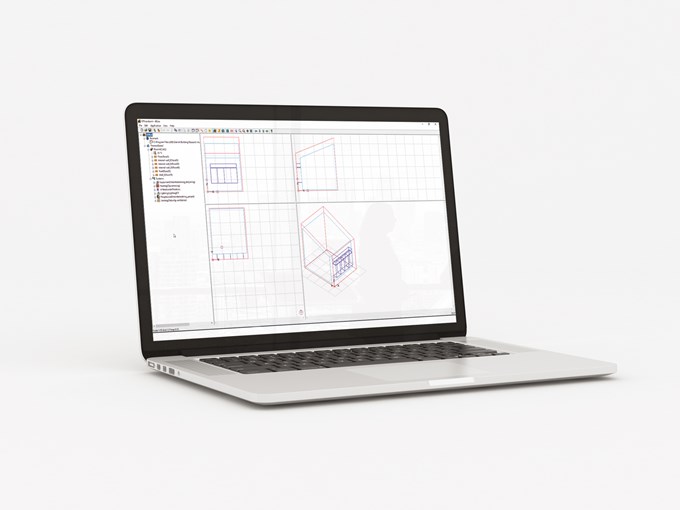Are you or your client considering natural or hybrid ventilation? If so, we’ve created this guide to help you during the concept phase so that you can discuss the options with your client and design with the best ventilation strategy possible.
The 5 Factors
-

External climate of the building
-

External noise and pollution
-

What is the key purpose or function of the building?
-

Room design and ventilation strategy
-

Opening areas
Some of the questions we'll answer
- What is the volume of air flow on cold days?
- How many times should the window open per hour and for how long on cold days?
- How do I find the effective opening area of a window?
- How do I assess a ventilation zone’s need for effective opening area?
Need more guidance for the early design phase?
We can support with determining opening areas, air change calculations, and more.
Quick disclaimers
The team of Ventilation Engineers at WindowMaster wrote this blog as a general guide based on their experience in Europe and North America with our customers. What we've found is that each country has unique regulations and paradigms regarding indoor climate and thermal comfort. Equally, each client and building have unique needs and requirements, so there is no one way of approaching natural ventilation design. If you’d like further advice on the considerations mentioned in the blog in relation to your project, then please don’t hesitate to reach out and ask. We offer many early-stage advisory services for free. When we speak of natural and hybrid ventilation, our context is specific to window and opening automation through intelligent controls.
Our free advisory services
1. External climate of the building
In our previous blog on External Climate and the Potential for Natural Ventilation, we discussed how geography, temperature and relative humidity can affect how often natural ventilation can be used in a building.
Here are the key takeaways from that blog:
- Based on our experience, we find that many locations outside the temperate climate zones can utilize a natural ventilation strategy for around 60-70% of the time.
- In the case of non-temperate climates, both purely naturally ventilation can be used as well as a hybrid ventilation approach. Hybrid ventilation can be an effective solution for getting fresh air in the building without compromising on comfort.
- Natural ventilation strategies outside temperate climates are normally an add-on, on top of the mechanical ventilation strategy.
2. External noise and pollution
When considering natural or hybrid ventilation via windows or other building openings, you and your clients might be concerned about potential noise and/or pollution challenges. In many cases, the sources of noise and pollution are the same and the strategies to minimize them are also often shared.
Luckily, there are multiple ways to minimize external noise.
Below are 4 strategies we often use:
Place openings away from the source
Depending on building design, we have seen designers experience success with positioning natural ventilation openings away from the noise source. This is done by placing openings at a higher vertical level, towards an interior courtyard, or towards a less busy road.
Noise reduction techniques
Another option to tackle noise issues for buildings is to engineer the openings with noise reduction. The addition of noise reducing insulation is also an option which we have seen work very well.
While noise reduction measures could sound complicated, it doesn’t have to be. We have direct experience working on projects where an intake with noise reduction has been designed in collaboration with sound specialists. The trick is to minimize the pressure drop in the opening in connection with the damping. You could also supplement your solution with mechanical extraction if the pressure loss becomes too great in the intake.
Double skin façade
This is a classic design technique to overcome issues with external noise while offering others benefits for the building. A double skin façade can offer the possibility of protecting the solar shading solution and building envelope. It can also protect the building from direct wind and rain.
Use of hybrid ventilation
Another approach is to switch between a natural and mechanical ventilation approach. For example, natural ventilation is used when the external conditions allow, but then mechanical ventilation can take over when external noise levels are higher.
Projects with noise reduction
Dealing with pollution concerns through the position of air intakes
Two strategies can be used:
- Position openings away from the source
- Hybrid ventilation with pollution sensors
If the building is in a densely populated area, then there are a few things to consider when deciding the position of building openings. In our experience, the building does not need to be very far away from heavily trafficked streets or have openings particularly high above street level before the air is significantly cleaner and openings for natural ventilation are fully acceptable.
From the design perspective, if the building is located just outside the city center or is a greater distance from a busy road, then no precautions normally need to be made.
As with noise mitigation, building openings can also be positioned towards inner courtyards or in the top of the building. You can also design for a hybrid ventilation solution with pollution sensors. When pollution levels are elevated, then the openings will close, and ventilation can be handled by the mechanical systems.
3. What is the key purpose or function of the building?
After assessing the building's surroundings, you can review the interior spaces and look at its function as well as the loads from people, appliances, and solar gains.
Areas with moderate loads
Areas with moderate load, such as walkways, common areas, atriums, office areas, storage halls, sports halls, etc. will almost always be suitable for natural ventilation.
Areas with dense loads
Areas such as meeting rooms, classrooms, canteens and the like, tend to have more dense loads. These areas may be best suited to hybrid ventilation, especially if you are in an area where winters can be cold and there are strict requirements for CO2 levels.
Ventilation requirements for areas such as classrooms and healthcare facilities can vary widely from country to country. Depending on the country and the context, natural ventilation will be sufficient while other times hybrid ventilation must be established to comply with the CO2 requirements without creating drafts.
Is there more or less than 15 m3 (530 ft3) room volume per person?
As a rule of thumb, if there is at least 15 m3 (530 ft3) or more per person, then natural ventilation is often a very viable route. However, if the room volume per person is below 15 m3 (530 ft3), then hybrid ventilation may be necessary, especially in regions with a cold winter to prevent cold drafts. Conversely, in the regions that tend to have very warm summers, then hybrid ventilation will likely be needed to insure comfort.
What is the volume of air flow on cold days?
If the building is in a region with cold winters, then you should evaluate how much air change is needed to keep the desired CO2 levels. If the volume of air flow can be held at 1 liter per second per m2 / 0.2 cfm per (sq ft) (approx. 1.5 h-1 at normal room height), then it will be possible in most cases to use natural ventilation without causing discomfort to building users. If the need for ventilation exceeds 1 liter per second per m2 / 0.2 cfm per (sq ft), then hybrid ventilation may be necessary to avoid drafts.
How many times should the window open per hour and for how long on cold days?
If your client is choosing an automated natural ventilation approach, then it might be helpful to provide them with an idea of how the system will work on cold days by using the dilution equation. This can help allay concerns clients have about drafts.

First, you find the room volume and the corresponding people load for a standard day.
Then, using the dilution equation, you can calculate how many minutes per hour and day the windows or flaps will need to be open on cold days to stay below the desired CO2-level.
Typically, we experience that windows can open 2 – 3 times per hour for 2-3 minutes each time on cold days without causing inconvenience for the users.
In Denmark, for example, we used this technique in a busy office building that uses natural ventilation all year round. Here we have an illustration of the calculation made in the design phase. The demand for the CO2-level was maximum 1000 ppm and with the given people load, you needed two openings (pulses) per hour.
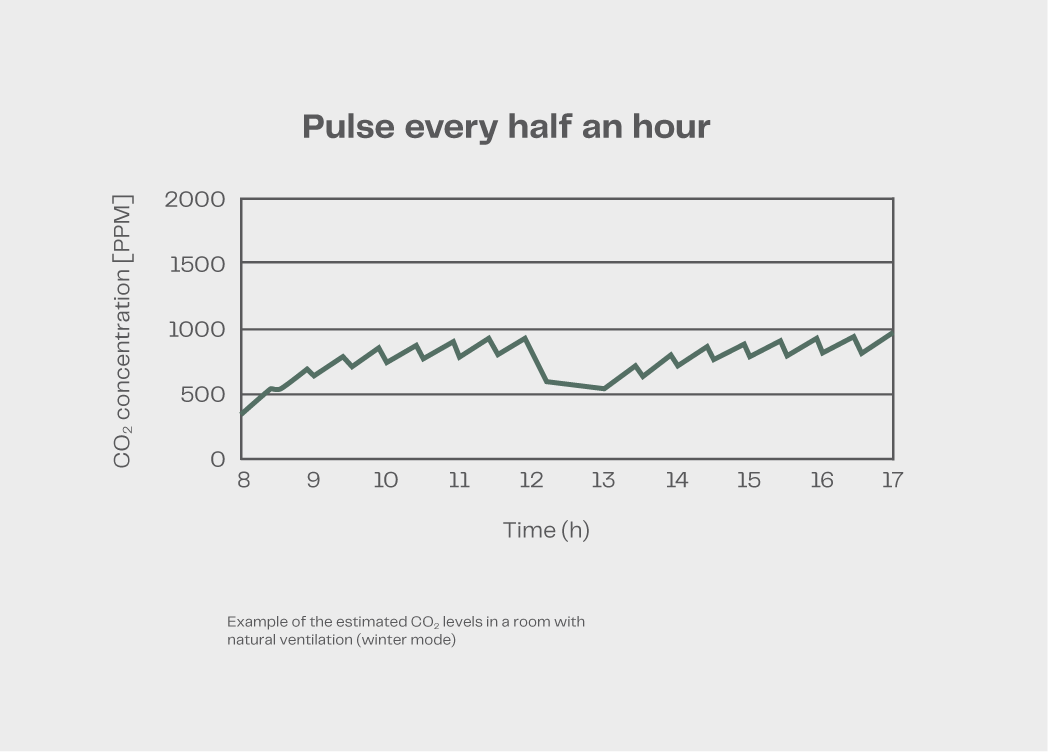
“After a testing period in collaboration with WindowMaster, we feel that the indoor climate is stable and fresh. We have been in the building for over a year and experienced all the seasons, including winter, with natural ventilation. We are very satisfied with the system, which opens and closes the windows in brief pulses throughout the working day."
Jan Haugaard
Owner and Director, Haucon
If you find, however, that your building needs more openings than 3 times per hour at 3 minutes each time to maintain an optimal indoor climate, then hybrid ventilation may be necessary.
If you’d like help with this calculation, we are happy to guide you, free of charge.
Occupancy load profiles
If it is found that natural ventilation cannot be used at 100% internal load, then hybrid ventilation can be an advantageous strategy (mechanical ventilation + natural ventilation).
In many instances, natural ventilation will be sufficient for a very large part of the time, even in critical zones. This applies to all types of rooms where the people load can vary greatly, such as office zones and meeting rooms. Therefore, hybrid ventilation can offer the benefit of 100% natural ventilation, when it makes sense, and supplement with mechanical ventilation when 100% internal load is reached.
High internal loads are something to be aware of in zones with a high maximum person load (such as event venues) if there is a limited possibility of opening area or transverse / stack ventilation.
4. Room design and ventilation strategy
Once you establish the function and use of the different rooms, you can then look at the design of the rooms based on depth to help you choose an appropriate natural ventilation strategy. In this section, we discuss the 3 core natural ventilation strategies plus tips for when to choose them.
In general, we recommend that openings be placed in the upper levels of an occupied area to avoid draft nuisances.
There are 3 core approaches to naturally driven ventilation:
Single-sided ventilation
Relies on one or more openings located on one side of the space.
Cross ventilation
Relies on openings located on both sides of the space. Cross ventilation is mainly wind driven which makes it very beneficial during summer days, when the difference of indoor and outdoor temperature is low. For windless locations such as cities, cross-ventilation might not be the best design option.
Stack ventilation
Relies on openings located at different heights in the façade or roof of a space. The air flow between the openings is driven by the thermal difference between inside and outside. However, the heat plumes created by internal loads will also contribute to the air flow.
How these strategies can or should be applied in a room depends on the depth of the room and the available driving forces. As an example, if the building is designed for mainly wind driven ventilation, then the natural ventilation can be enhanced by taking the prevailing winds into consideration when placing the openings.
While these are our rules of thumb for room depth and ventilation strategy, we recommend that you consult your local regulations and requirements. If you need assistance with this, please don’t hesitate to ask us.
Ventilation zones with limited room depth
If the area to be ventilated has a maximum depth of 2.5x the floor to ceiling height, without exceeding 10m (33 ft.), then the area can often be ventilated by single-sided ventilation.
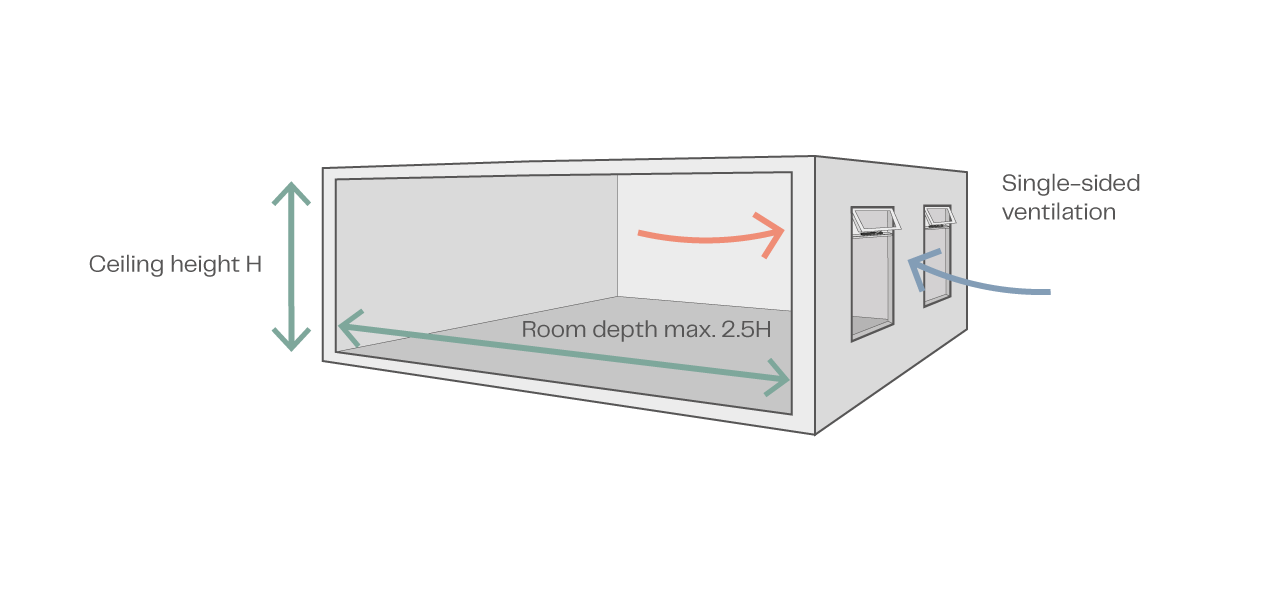
However, if the area is heavily congested, such as a classroom, then mechanical assistance will often be required to comply with building regulations. However, this is not the case in all countries. In some countries, single-sided, cross or stack ventilation is enough.
Ventilation zones in deeper rooms
If the area to be ventilated is deeper than 2.5x the floor to ceiling height, then cross ventilation or stack ventilation will normally be required to achieve adequate ventilation. As a rule of thumb, an area using cross- or stack ventilation can often have a limiting depth of room of maximum 5x the floor to ceiling height.
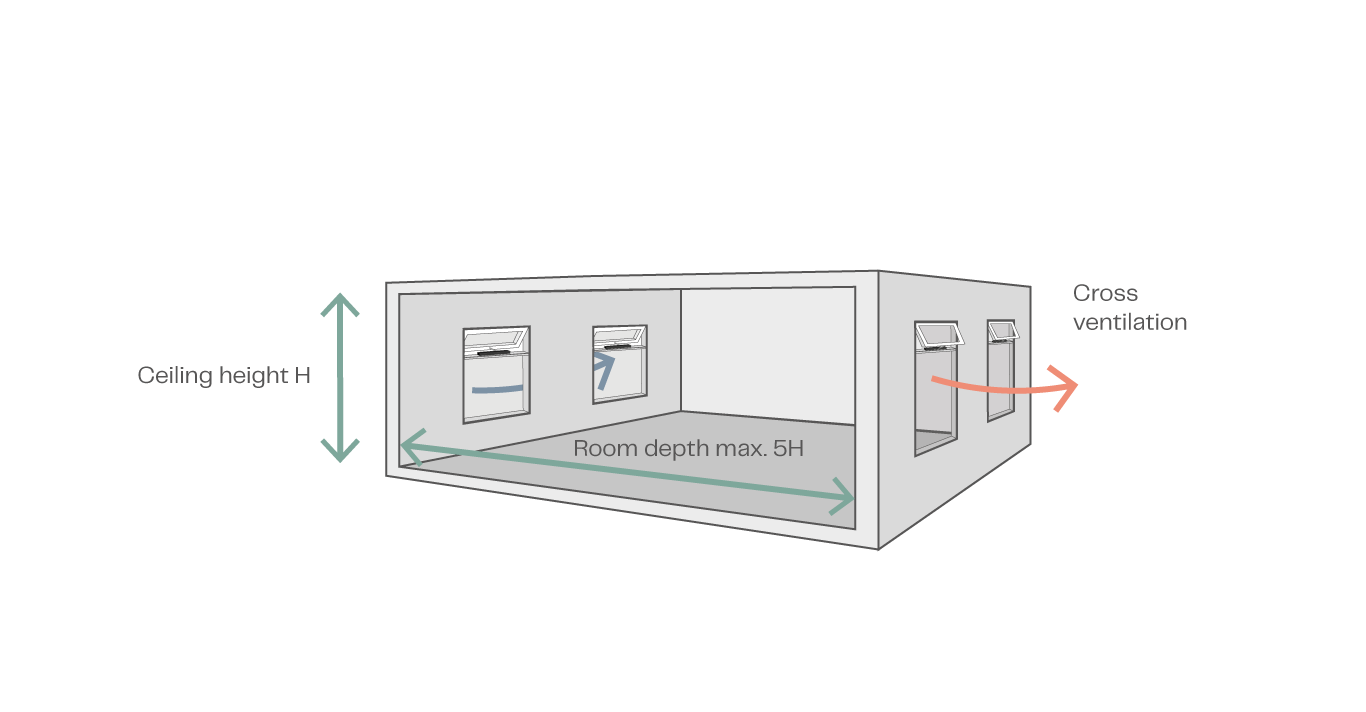
If it is not possible to establish cross ventilation or stack ventilation, then an option is to establish an exhaust at the back of the room, preferably with heat recovery as a supplement. A balanced mechanical ventilation system can also work as supplement.
If the area is deeper than approximately 5x the floor to ceiling height, then cross ventilation, stack ventilation, and single-sided ventilation with assistive extraction also begin to have their limitations, and one should consider using hybrid ventilation.
Large buildings with central atriums
If a large building has a central atrium with openings in the roof and with offices or work spaces bordering it, then the horizontal distance from the office facade to the edge/start of the atrium should typically not be more than 5x the floor to ceiling height.
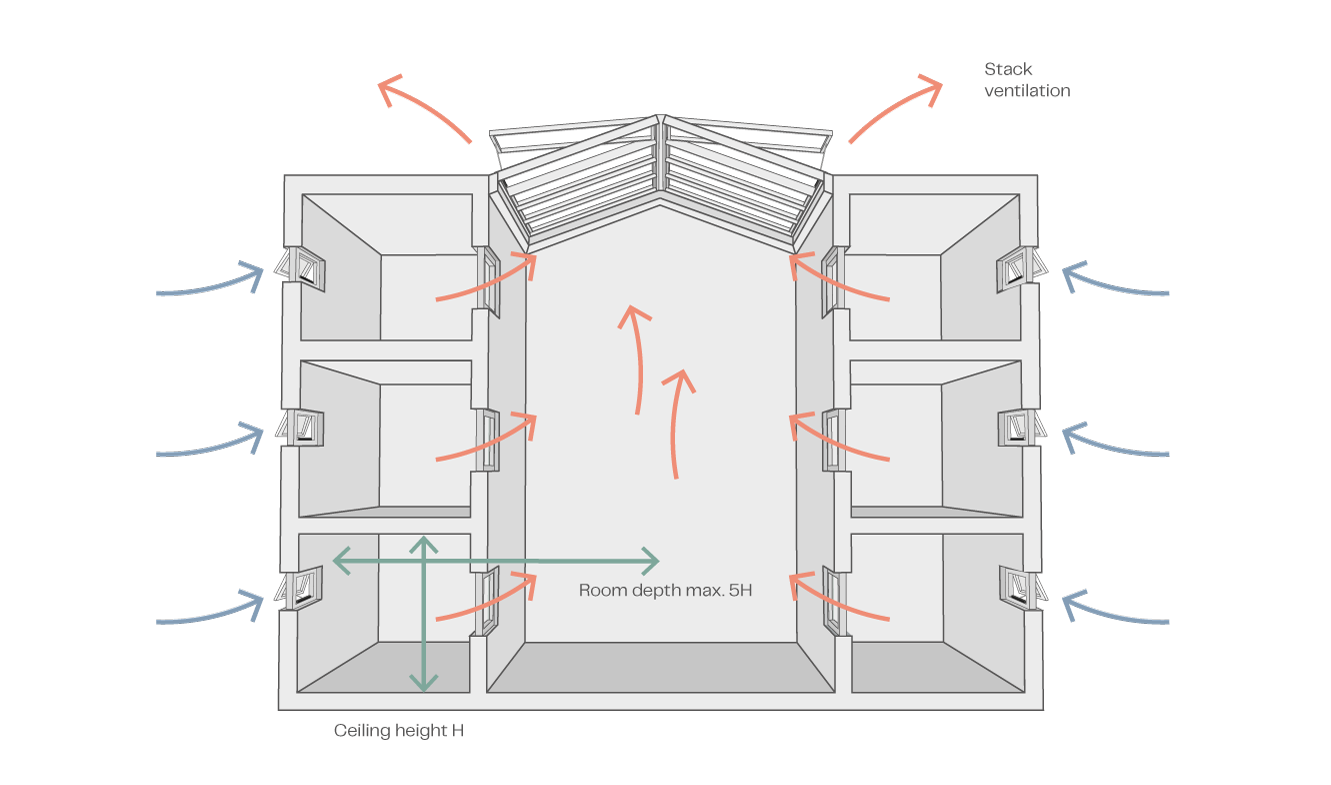
Avoiding drafts
Care must be taken when establishing permanent workspaces inside the atrium with a high glass roof, regardless of whether you have mechanical or natural ventilation. The reason for this is that the roof can cause drafts if the air directly under the roof cools. However, if the workspaces have their own roof, then drafts should be avoided.
If you have workspaces along the border of the atrium, then we recommend placing a type of guard or barrier that closes near the floor to avoid drafts at the feet.
Large buildings with an atrium
A building where the offices are located around a large central atrium may become too high for natural stack ventilation. We have extensive experience with buildings that are 5-6 stories high that use natural stack ventilation. If the building you are planning is taller than this, a closer examination is recommended, and it may require assisted mechanical extraction at the top of the building to ensure fresh air on all floors.
For the large atrium office buildings, the opening area of the roof should be about 1.5x the total opening area of the facades to ensure that all floors get fresh air and that only the roof is used for returns. For example, if an atrium is connected to a natural ventilation area of 10,000 m2 (108,000 f2), then the effective opening area of the roof should be approximately 90 m2 (969 ft2). This is based on the assumption that the total effective opening area corresponds to approximately 1.5% of the naturally ventilated area. However, it is rare that all openings in the facade are fully open at the same time, and in practice, the opening area in the roof can therefore be scaled down a bit.
Night cooling
The use of cross and stack ventilation can greatly improve the effectiveness of night cooling. When possible, doors between offices spaces can be opened to increase the air flow through the building during the nighttime.
5. Opening areas
Effective opening areas for natural ventilation
In the early design phase, you can use the following guides to get a good feel for the extent of effective opening area per space. When you have more detailed knowledge of the use of the space, then the effective opening areas can be adapted. Determining the number and type of openings is something that can be defined a bit later in the design process.
How do I find the effective opening area of a window?
Initially, we describe how we define the effective opening area.
For the natural ventilation system, the effective opening area is defined by:

Example of the geometric opening area (Ageo) for a window is illustrated in the figure below.
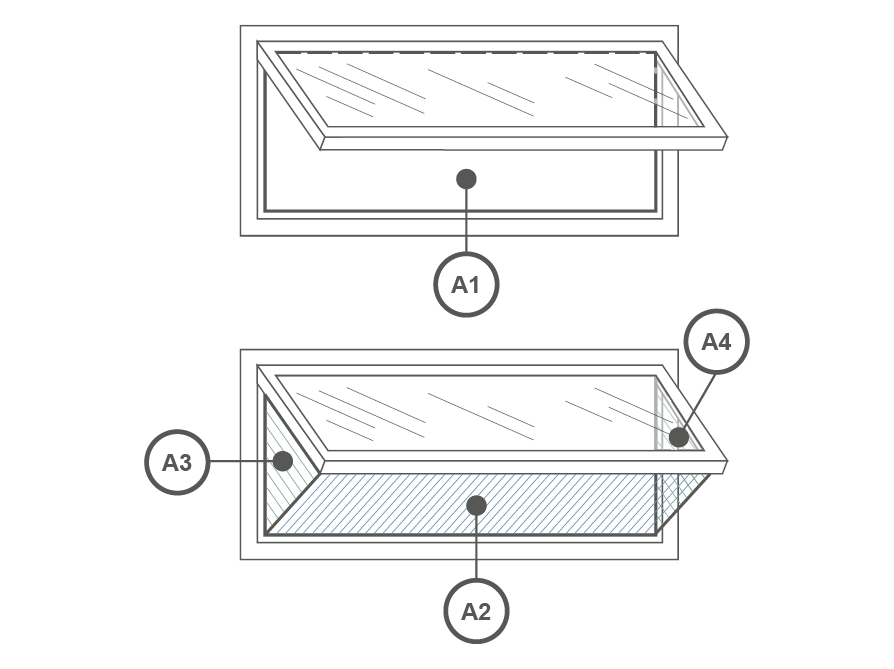
The geometric opening area is given by the sum of A2, A3 and A4. If A1 is less than the sum of A2, A3 and A4, then it is A1 which is to be used as the geometric opening area of the window.
The opening’s outflow coefficient (Cd) depends on the friction and contraction of the opening. For windows and other larger openings, the outflow coefficient (Cd) will be in the order of 0.6 - 0.7.
If screens are installed on the operable window, it will affect the discharge coefficient and can also affect the geometrical opening area.
It is always the smallest possible opening which the air flows through that defines the geometrical opening area. Therefore, the screens will only affect the geometrical opening area if the opening area through the screen is the smallest possible area which the air passes through.
The discharge coefficient of top hung window with a bug screen is typically reduced from 0.6-0.7 to 0.3-0.4. This will depend on the porosity and material of the screen.
How do I assess a ventilation zone’s need for effective opening area?
When you know the location of the zone’s possible openings to the exterior, and thereby know the natural ventilation principle, you can then find an initial estimate of the effective opening area for each area to be ventilated with a simple calculation. The starting point is the room or zone’s effective floor area and ventilation principle, as illustrated below.
Room with single-sided ventilation:
Aeff is equal to 2% of the floor area
Cross- or buoyancy ventilation:
Aeff equal to 1.5% of the floor area
Once you have estimated the effective opening areas for each zone and you have established their approximate location, then it is possible to find the area's natural air exchange.
We have an Air Change Rate Calculator you can use for this purpose.
Conclusion
If you'd like to confirm your calculations or get advice on your initial thoughts, don't hesitate to reach out to us.
If you're interested in learning more about natural ventilation design, then stay tuned for our next blog about determining window openings, location, and sizing.
Below are software guides to help you model and get more detailed calculations for air flow.
Contact
Get in touch





